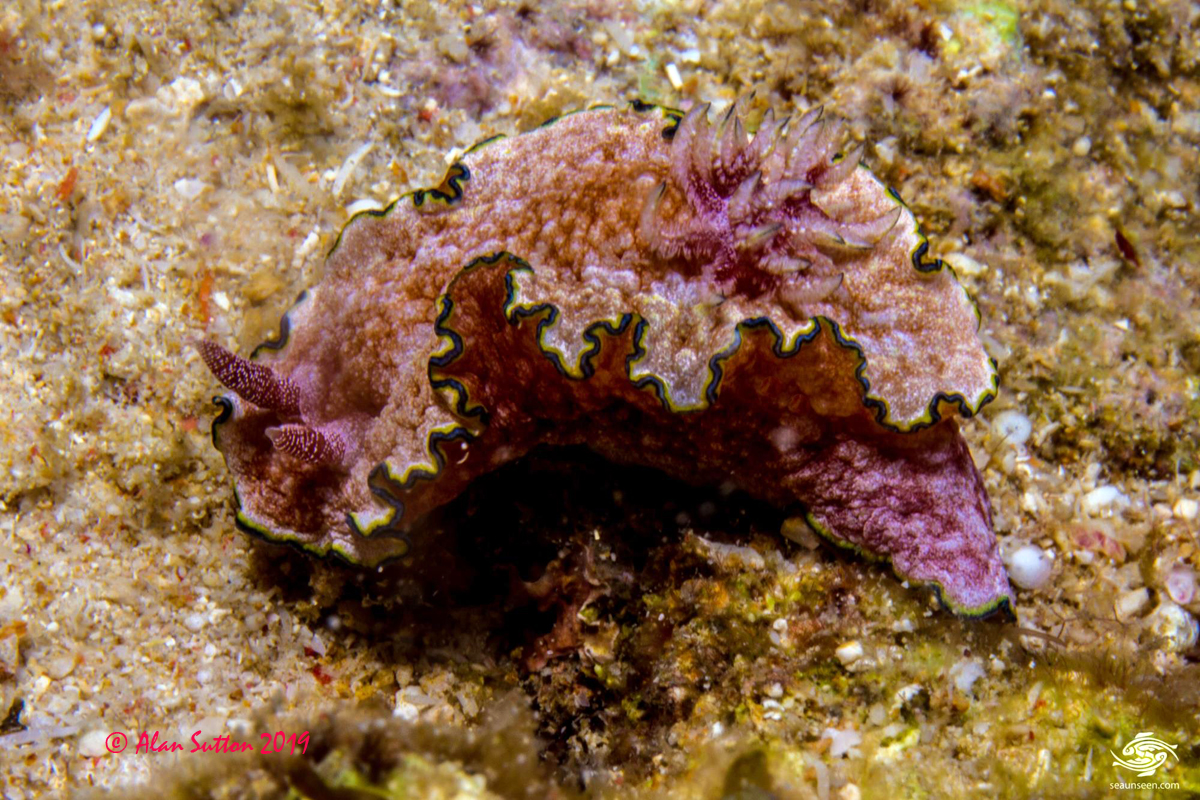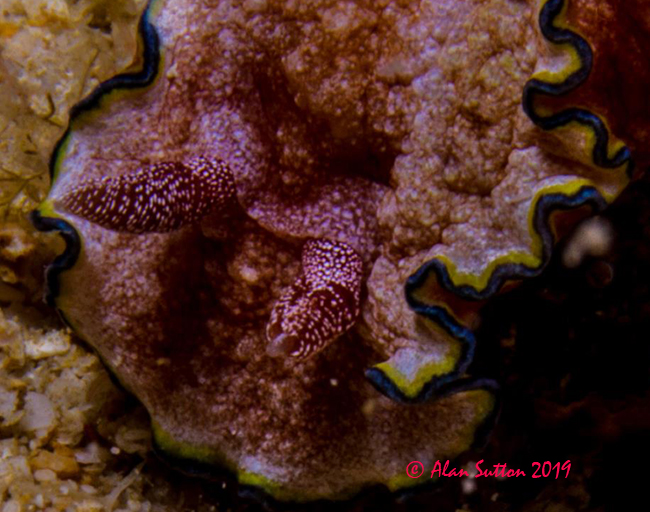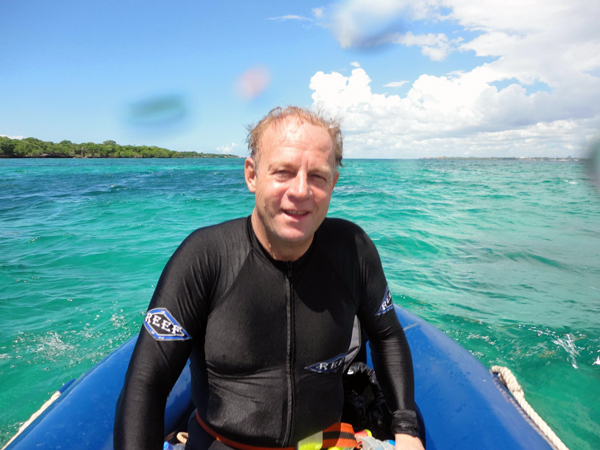 |
Glossodoris sp. 1
Image courtesy of Alan SuttonDar es Salaam in Tanzania
 |
Glossodoris sp. 1 (undescribed)
This is one of the Glossodoris cincta lookalikes. Each can be separated by their differences in color of the marginal lines. While G. cincta has two colors - blue followed by black, Glossodoris sp. 1 (NSSI 2nd ed) has three marginal bands - light blue, then dark blue and yellow. Glossodoris sp. 1 in NSSI 1st edition has now been described and is now Glossodoris andersonae. The marginal bands in this species are a series of yellow spots followed by black and light blue bands. The rhinophores of Glossodoris sp. 1 as seen in the image to the left are distinctive being red with white specks on the lamellae. The double spiral gill vibrates providing the species better access to oxygen. Alan's observation here expands the geographic range of this large species, which was previously know only from the Philippines, to Tanzania. Good show Alan. Reference: Matsuda S.B. & Gosliner T.M. (2018). Glossing over cryptic species: Descriptions of four new species of Glossodoris and three new species of Doriprismatica (Nudibranchia: Chromodorididae). Zootaxa. 4444(5): 501-529.
Sammamish, WA 98074 Apr. 2019 Send Dave email at davidwbehrens@gmail.com
|
Alan Sutton on location

I am originally from South Africa, I was born in Durban in 1959 but spent most of my early life and school in Pietermaritzburg. I started diving at an early age, when I was about 4. I saw an article in a magazine with pictures of Jacque Cousteau with a mask on. My father had a pair of old flying goggles and on the next family holiday to the sea I took them with and tried them out. Needless to say they leaked but I got a glimpse of a few fish that I can still remember today. I started free diving a lot in the holidays when I was about 12 years old, diving with my cousins who were into spear fishing and used to dive with the then South African Champions who taught me how to dive. I used to go along and watch. When I was at University in Durban where I studied Law and then Maritime Law, I dived a lot for crayfish, a hobby which I continued until I moved to Dar es Salaam in Tanzania in 1999. I had my first seawater fish tank when I was 16 and kept up the hobby until I moved to Tanzania. In Tanzania I have dived Pemba Island, Zanzibar, Mafia Island, Kilwa and Mtwara all of which have world class diving. I have dived the Kwa-Zulu Natal North and South coasts extensively as well as the Transkei coast and also done some diving in Dahab in Egypt. My favorite dive spot ever is the north east point of Mafia Island. Big drop offs with a strong current and a lot of life ranging from small stuff to large trevally's, dog tooth tuna, very large bass and a few sharks. I only switched across to Scuba about 6 years ago and have done about 500 dives maybe slightly more. I have Padi Rescue Diver and Deep dive qualifications. Usually I dive at least twice a week but sometimes up to six times a week if the conditions are good. I mainly dive with the Dar es Salaam Yacht Club , we have a dedicated dive boat and have 7 scheduled dives a week. We dive in the vicinity of Dar es Salaam either just north which has some good walls or just to the south which has some wrecks. |
I have a blog called seaunseen.com that I and a friend have as a hobby and the aim is to try to document the sea life in Tanzania. For years the Tanzanian coast has suffered from dynamite fishing but since November 2017 the Government have had a clampdown on it and it seems to have completely stopped. In the short space of time since November the fish life is rebounding amazingly well and I think we will have some world class diving in about three years time around Dar es Salaam. Visibility in Dar es Salaam varies from about 5 meters to up to at least 30 meters. On the the islands Pemba, Zanzibar and Mafia which have no rivers per se on them , in the right season visibility can be as good as it is possible to get with salt water.
I have only seen two of these and one other person at the dive section has seen one other as well separate to the ones I saw so three in total.
The one in the images was photographed on the 24th May 2018 in approximately 18 meters on the top of Big T Reef off Dar es Salaam, which is a Seaward Reef about 4 km offshore dropping off to 50 meters . It was moving across the sand in a mixed rubble/sandy area with isolated coral outcrops. The other specimen I saw on Kankadya Patches off Dar es Salaam in 2016 but my main strobe battery had run flat and I could not take any images. It was right at the end of the dive when the signal had already been given to go up that I spotted it.
Send Alan email at alan@robmarine.com

|
